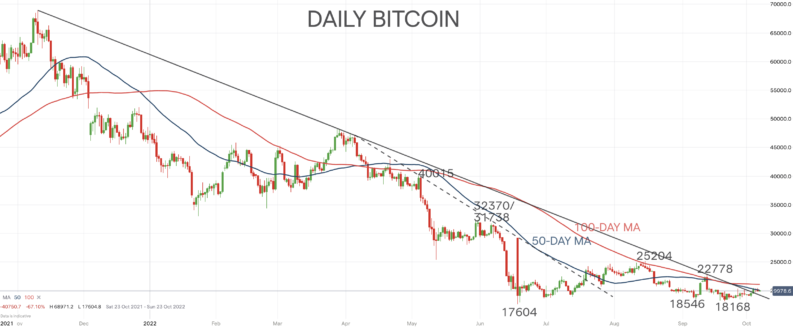Key points:
- Markets Are Focused on The Release Of The US Employment Report Today
- Risk Assets Have Bounced In October After September Weakness
- Bitcoin (and cryptocurrencies) remain in consolidation phases
Today’s US Employment report will be keenly watched as ever, particularly to see if the hawkish path taken by the Fed in 2022 to curb aggressive inflationary pressures is beginning to impact on a still relatively strong US labour market. This data event will likely have notable impacts on global financial markets and here we focus on the effect on the cryptocurrency space, with a spotlight on key trigger levels for Bitcoin (BTC).
Global Financial Markets Are Focused on The Release Of The Key US Employment Report Today
Today sees the release of the US Employment report for September, incorporating the always much-watched Non-Farm Payroll (NFP) data. Although this data is always viewed as important, this month’s release could be all the more significant as there have been signs from other data that the US labour market is starting to weaken. Up until now, although the Fed have repeatedly hiked rates through 2022, the labour market has remained strong. Consensus numbers to watch for today according to Bloomberg are 225K for the NFP release with unemployment seen holding at 3.7%.
Also Read: Can Ethereum and Bitcoin Solve Their Energy Use Problem
Risk Assets Have Bounced In October After September Weakness
Global risk assets tried to recover in early October, having suffered notable losses in September. Of particular note was the move by US and many European stock averages to new bear market lows for 2022. The rebound seen to start Q4 this week has, however, seen the S&P 500 posted its best two-day rally since 2020.
Cryptocurrencies have seen a partial decoupling from global and particularly US stock indices in September, with most cryptocurrencies outperforming the share averages and broadly holding above May/June bear market lows.
Bitcoin (And Cryptocurrencies Generally Remain in Short- And Intermediate-Term Consolidation Phases
Broadly speaking., most of the major cryptocurrencies have moved into short-term consolidation phases since the early part of September, having held during recent losses from August above the bear markets lows that were set mostly in the second quarter of this year in May and or June.
This means that the intermediate-term basing patterns that have built since these bear market lows were established are still mostly intact, highlighting consolidation activity on a medium-term outlook as well as on the short-term view.

For Bitcoin in particular, this has seen a series of lower lows in lower highs since the August recovery peak was established at 25204, with the latter September low undercutting the early September low (at 18546) down to 18168, but critically holding above the June bear market low at 17604.
Moreover, the 50- and 100-day Moving Averages (MAs) converged in September but failed to signal a definitive bullish cross. These MAs should be monitored into October and particularly in the wake of the aforementioned US Employment release, for signs of either a more sustainable recovery, or for a renewal of intermediate-term bearish forces.
We carry a bullish bias for BTC in the short-term and see risks into October for a challenge back to the September peak at 22778, with overshoot threat possibly still higher for the month towards 25204. The Q4/ year-end risk is for a more bullish theme to resurface to target chart resistances at 31738/ 32370.
On the flip side, a divergence of the abovementioned MAs would encourage a Bitcoin price retest of the recent low at 18168, then on to challenge the June low at 17604, and possibly a more bearish extension through here towards 15000 and even beyond.




